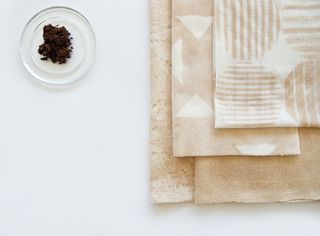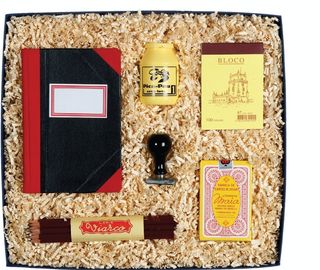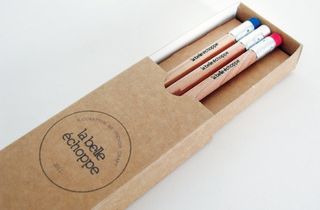Trend report: The real thing
Mass production and digitalisation have given consumers a yearning for hand-crafted products with heritage, causing designers to reimagine tradition and authenticity

Digital media is also helping brands capitalise on increasing patriotic fervour. Online stores that let consumers buy goods direct from their country of origin, such as La Belle Echoppe and A Vida Portuguesa, are springing up. The former, created by French lifestyle blog redingote.fr, is an online boutique dedicated to French-made products. The online collection ranges from classic Breton shirts made in Brittany to Opinal knives made in Savoie, and it encourages users to shop by region as well as giving an insight into each product’s origin and cultural history. Similarly, online store A Vida Portuguesa aims to promote forgotten everyday objects by offering customers over 1,000 different Portuguese-made products that have either maintained their original packaging, are handmade, or represent indigenous Portuguese craftsmanship.
As well as nationalism, brands are also using hyper-localism – tracing products back to exact locations – to promote their wares. 2010’s Savile Row Field Day event played on the theme of provenance, with local wool producers parading their sheep down the road. Some designers are also bringing where they live and where they were born into their work. A recent graduate from Central St Martins’ MA Textile Futures course, Hyun Jin Jeong collects soils from various locations in South Korea and the UK, exploring the use of earth as a material for textile dyeing and emphasising the aesthetic value of this natural material.
In post-industrial nations, shoppers and designers have a renewed, patriotic focus on the local – whether it be raw materials, workers or production – and a strong drive to rediscover a country’s, or a city’s, pride in a once-strong manufacturing heritage.

Heritage modern
Facing an ever-changing marketplace, consumers are finding reassurance in heritage brands that have survived the test of time. By gleaning elements of historical reference and imagination, younger brands are able to build instant heritage for themselves too.
Savile Row tailor E. Tautz supplements the 1920s feel of its clothing lines with antique postcards, on which customers are invited to ‘pick up their pens and scribble us a postcard with anecdotes, quotes and tips on living the life less ordinary’. More notably, Italian high-end stationery brand Moleskine may have only started in 1997, but it has successfully claimed instant heritage through linking itself with famous writers and artists such as Van Gogh, Hemingway and Picasso, who used similar notebooks to Moleskine’s own.
Heritage and story are important, and can successfully work hand-in-hand with notions of utility and fitness for purpose. Communicating a brand’s story, old or new, will create a stronger connection between consumer and product.

Convivial crafting
Hands-on classes in carpentry, leatherworking, pottery and other traditional crafts are gaining popularity. Consumers want to know how to make the products they love, using the same methods as the brands they love.
Cecilie Maurud Barstad, one half of design studio Gilles & Cecilie, sees craft’s revival as a simple way of getting together in complicated times. “For me, craft is a simple activity that can be done together with friends, family or communities,” she reasons. “It brings people together. Also, the joy of producing something over a fairly short time can be very rewarding.”
Brands are using craft to educate their consumers. Levi’s, as part of its Go Forth campaign, is capitalising on the trend of getting together and ‘doing’ something by setting up mobile workshops in cities such as San Francisco, New York and Berlin that invite locals to learn to screen-print. They provide free screen-printing equipment, supplies and courses helping consumers produce their own T-shirts, digital artwork and postcards.
Similarly, Diesel’s project, School of Island Life, recently hosted a workshop with famous taxidermist Charlie Gates in which he showed participants DIY taxidermy. Smaller labels have also been host to more unusual craftsmen, such as B Store’s Bleeding Thumbs Whittling Club, where people revive the old tradition of using knives to create wooden objects.
Craft can be communicated through education, as well as transparency of how products are made. In fact, teaching artisanal skills is likely to be the most powerful way of connecting with consumers.
Get the Creative Bloq Newsletter
Daily design news, reviews, how-tos and more, as picked by the editors.

Thank you for reading 5 articles this month* Join now for unlimited access
Enjoy your first month for just £1 / $1 / €1
*Read 5 free articles per month without a subscription

Join now for unlimited access
Try first month for just £1 / $1 / €1
The Creative Bloq team is made up of a group of design fans, and has changed and evolved since Creative Bloq began back in 2012. The current website team consists of eight full-time members of staff: Editor Georgia Coggan, Deputy Editor Rosie Hilder, Ecommerce Editor Beren Neale, Senior News Editor Daniel Piper, Editor, Digital Art and 3D Ian Dean, Tech Reviews Editor Erlingur Einarsson, Ecommerce Writer Beth Nicholls and Staff Writer Natalie Fear, as well as a roster of freelancers from around the world. The ImagineFX magazine team also pitch in, ensuring that content from leading digital art publication ImagineFX is represented on Creative Bloq.
